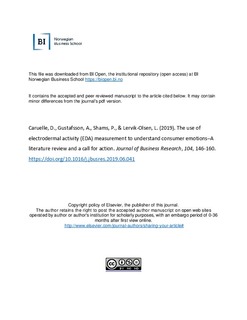| dc.contributor.author | Caruelle, Delphine | |
| dc.contributor.author | Gustafsson, Anders | |
| dc.contributor.author | Shams, Poja | |
| dc.contributor.author | Lervik-Olsen, Line | |
| dc.date.accessioned | 2019-11-13T13:13:26Z | |
| dc.date.available | 2019-11-13T13:13:26Z | |
| dc.date.created | 2019-08-21T15:51:15Z | |
| dc.date.issued | 2019 | |
| dc.identifier.citation | Journal of Business Research. 2019, 104 (November (11)), 146-160. | nb_NO |
| dc.identifier.issn | 0148-2963 | |
| dc.identifier.uri | http://hdl.handle.net/11250/2628286 | |
| dc.description.abstract | Electrodermal activity (EDA) is a psychophysiological indicator of emotional arousal. EDA measurement was first employed in consumer research in 1979 but has been scarcely used since. In the past decade, the ease of access to EDA recording equipment made EDA measurement more frequent in studies of consumer emotions. Additionally, recent calls to include physiological data in consumer studies have been voiced, which in turn is increasing the interest in EDA. Such a growing interest calls for assessing why and how EDA measurement has been used and should be used in consumer research. To this end, we undertook a critical review of studies of consumer emotions that employed EDA measurement. We found that most of these studies did not sufficiently report how they recorded and analyzed EDA data, which in turn impeded the replication of the findings. We therefore make recommendations derived from the psychophysiology literature to help consumer researchers get meaningful insights from EDA measurements. Finally, we call on researchers to be more transparent when reporting how they recorded and analyzed EDA data. | nb_NO |
| dc.language.iso | eng | nb_NO |
| dc.rights | Attribution-NonCommercial-NoDerivatives 4.0 Internasjonal | * |
| dc.rights.uri | http://creativecommons.org/licenses/by-nc-nd/4.0/deed.no | * |
| dc.title | The use of electrodermal activity (EDA) measurement to understand consumer emotions – A literature review and a call for action | nb_NO |
| dc.type | Journal article | nb_NO |
| dc.type | Peer reviewed | nb_NO |
| dc.description.version | acceptedVersion | nb_NO |
| dc.source.pagenumber | 146-160 | nb_NO |
| dc.source.volume | 104 | nb_NO |
| dc.source.journal | Journal of Business Research | nb_NO |
| dc.source.issue | November (11) | nb_NO |
| dc.identifier.doi | 10.1016/j.jbusres.2019.06.041 | |
| dc.identifier.cristin | 1717780 | |
| cristin.unitcode | 158,11,0,0 | |
| cristin.unitname | Institutt for markedsføring | |
| cristin.ispublished | true | |
| cristin.fulltext | postprint | |
| cristin.qualitycode | 2 | |

